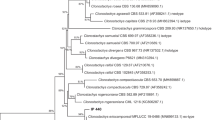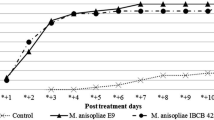Abstract
Haemaphysalis longicornis (Acari: Ixodidae) is an important vector tick that is widely distributed around the world. In many regions, this tick acts as vector of a wide range of pathogens to humans and animals, and its control is mainly based on the use of chemical pesticides. However, the occurrence of some adverse effects, such as tick resistance to pesticides and food and environmental contamination, are driving the need to develop more effective and environmentally sound approaches to control and prevent ticks. As an alternative control strategy, entomopathogenic fungi have been extensively used for the control of pests and cause high mortality in various ticks. In this study, we identified four isolates of Beauveria bassiana sensu lato from insects and investigated their pathogenicity against different developmental stages of H. longicornis (eggs, unfed larvae, unfed nymphs and engorged females). Phylogenetic analysis demonstrated that the four isolates of B. bassiana clustered into two clades. Four isolates showed different acaricidal qualities: the isolate from Cerambycidae (EF3) exhibited the highest pathogenicity to all developmental tick stages tested. High doses (1 × 107 conidia/ml) of the clade I fungi collected from Cryptotympana atrata fabricus (Cicadidae) (EF1), Cimicidae (EF2), and Boettcherisca peregrine (Sarcophagidae) (EF4) also showed virulence against H. longicornis, with high doses of the fungi application causing higher mortality than control group. Altogether, this study demonstrated that all four isolates of B. bassiana showed high virulence toward different developmental stages of H. longicornis, and therefore, they can be of potential use as biological control agents of ticks.

Similar content being viewed by others
References
Alonso-Díaz MA, García L, Galindo-Velasco E, Lezama-Gutierrez R, Angel-Sahagún CA, Rodríguez-Vivas RI, Fragoso-Sánchez H (2007) Evaluation of Metarhizium anisopliae (Hyphomycetes) for the control of Boophilus microplus (Acari: Ixodidae) on naturally infested cattle in the Mexican tropics. Vet Parasitol 147:336–340
Angelo IC, Fernandes EKK, Bahiense TC, Perinotto WMS, Gôlo PS, Moraes APR, Bittencourt VREP (2012) Virulence of Isaria sp. and Purpureocillium lilacinum to Rhipicephalus microplus tick under laboratory conditions. Parasitol Res 111:1473–1480
Arruda W, Lübeck I, Schrank A, Vainstein MH (2005) Morphological alterations of Metarhizium anisopliae during penetration of Boophilus microplus ticks. Exp Appl Acarol 37:231–244
Bittencourt VREP, Mascarenhas AG, Faccini JLH (1999) Mecanismo de infecção do fungo Metarhizium anisopliae no carrapato Boophilus microplus em condições experimentais. Ciência Rural 29:351–354
Brackney DE, Armstrong PM (2016) Transmission and evolution of tick-borne viruses. Curr Opin Virol 21:67–74
Cafarchia C, Immediato D, Iatta R, Ramos RA, Lia RP, Porretta D, Figueredo LA, Dantas-Torres F, Otranto D (2015) Native strains of Beauveria bassiana for the control of Rhipicephalus sanguineus sensu lato. Parasit Vectors 8:80. https://doi.org/10.1186/s13071-015-0693-9
Castro-Janer E, Rifran L, Gonzalez P, Piaggio J, Gil A, Schumaker TTS (2010) Rhipicephalus (Boophilus) microplus. resistance to fipronil in Uruguay evaluated by in-vitro bioassays. Vet Parasitol 169:172–177
De la Fuente J, Estrada-Peña A, Venzal JM, Kocan KM, Sonenshine DE (2008) Overview: Ticks as vectors of pathogens that cause disease in humans and animals. Front Biosci 13:6938–6946
De la Fuente J, Contreras M, Estrada-Peña A, Cabezas-Cruz A (2017) Targeting a global health problem: vaccine design and challenges for the control of tick-borne diseases. Vaccine 35:5089–5094
Fernandes ÉKK, Bittencourt VREP (2008) Entomopathogenic fungi against South American tick species. Exp Appl Acarol 46:71–93
Fernandes ÉKK, Bittencourt VREP, Roberts DW (2012) Perspectives on the potential of entomopathogenic fungi in biological control of ticks. Exp Parasitol 130:300–305
Gardes M, Bruns TD (1993) ITS primers with enhanced specificity for basidiomycetes-application to the identification of mycorrhizae and rusts. Mol Ecol 2:113–118
Gindin G, Samish M, Zangi G, Mishoutchenko A, Glazer I (2003) The susceptibility of different species and stages of ticks to entomopathogenic fungi. Exp Appl Acarol 28:283–288
Humbert R (1996) Fungi identification. In Manual of techniques in insect pathology USDA-ARS Plant Protection Research. Ithaca, New York, pp 153–185
Jongejan F, Uilenberg G (2004) The global importance of ticks. Parasitology 129:S3–S14
Kaaya GP, Samish M, Glazer I (2000) Laboratory evaluation of pathogenicity of entomopathogenic nematodes to African tick species. Ann NY Acad Sci 916:303–308
Kim KH, Yi J, Kim G, Choi SJ, Jun KI, Kim NH, Choe PG, Kim NJ, Lee JK, Oh MD (2013) Severe fever with thrombocytopenia syndrome, South Korea, 2012. Emerg Infect Dis 19:1892–1894
Kirkland BH, Cho E, Keyhani NO (2004) Differential susceptibility of Amblyomma maculatum and Amblyomma americanum (Acari: Ixodidea) to the entomopathogenic fungi Beauveria bassiana and Metarhizium anisopliae. Biol Control 31:414–421
Lu BL, Wu HY (2003) Classification and Identification of important medical insects of China. Henan Science and technology Publishing House, Henan, pp. 661–665 (in Chinese)
Mahara F (1997) Japanese spotted fever: report of 31 cases and review of the literature. Emerg Infect Dis 3:105–111
Matsuo T, Okura N, Kakuda H, Yano Y (2013) Reproduction in a Metastriata tick, Haemaphysalis longicornis (Acari: Ixodidae). J Acarol Soc Japan 22:1–23
Neelapu NR, Reineke A, Chanchala UM, Koduru UD (2009) Molecular phylogeny of asexual entomopathogenic fungi with special reference to Beauveria bassiana and Nomuraea rileyi. Rev Iberoam Micol 26:129–145
Ostfeld RS, Price A, Hornbostel VL, Benjamin MA, Keesing F (2006) Controlling ticks and tick-borne zoonoses with biological and chemical agents. Bioscience 56:383–394
Perinotto WSM, Angelo IC, Golo PS, Quinelato S, Camargo MG, Sá FA, Bittencourt VREP (2012) Susceptibility of difference populations of ticks to entomopathogenic fungi. Exp Parasitol 130:257–260
Pound JM, Miller JA, George JE, Fish D, Carroll JF, Schulze TL, Daniels TJ, Falco RC, Stafford KC, Mather TN (2009) The United States Department of Agriculture’s North-east area-wide tick control project: summary and conclusions. Vector Borne Zoonotic Dis 9:439–448
Rainey T, Occi JL, Robbins G, Egizi R A (2018) Discovery of Haemaphysalis longicornis (Ixodida: Ixodidae) parasitizing a sheep in New Jersey, United States. J Med Entomol 55:757–759
Ren Z, Wang D, Ma A, Hwang J, Bennett A, Sturrock HJ, Fan J, Zhang W, Yang D, Feng X, Xia Z, Zhou XN, Wang J (2016) Predicting malaria vector distribution under climate change scenarios in China: challenges for malaria elimination. Sci Rep 6:20604. https://doi.org/10.1038/srep20604
Roy BC, Estrada-Peña A, Krücken J, Rehman A, Nijhof AM (2018) Morphological and phylogenetic analyses of Rhipicephalus microplus ticks from Bangladesh, Pakistan and Myanmar. Ticks Tick-Borne Dis 9:1069–1079
Samish M, Ginsberg H, Glazer I (2004) Biological control of ticks. Parasitology 129:S389–S403
Sousa LAD, Pires HB, Soares SF, Ferri PH, Ribas P, Lima EM, Furlong J, Bittencourt VREP, Perinotto WM, Borges LM (2011) Potential synergistic effect of Melia azedarach fruit extract and Beauveria bassiana in the control of Rhipicephalus (Boophilus) microplus (Acari: Ixodidae) in cattle infestations. Vet Parasitol 175:320–324
Souza Higa LDO (2015) Acaricide resistance status of the Rhipicephalus microplus in Brazil: a literature overview. Med Chem 5:326–333
Sun M, Ren Q, Guan G, Liu Z, Ma M, Gou H, Chen Z, Li Y, Liu A, Niu Q, Yang J, Yin H, Luo J (2011) Virulence of Beauveria bassiana, Metarhizium anisopliae and Paecilomyces lilacinus to the engorged female Hyalomma anatolicum anatolicum tick (Acari: Ixodidae). Vet Parasitol 180:389–393
Sun M, Ren Q, Guan G, Li Y, Han X, Ma C, Yin H, Luo J (2013) Effectiveness of Beauveria bassiana sensu lato strains for biological control against Rhipicephalus (Boophilus) microplus (Acari: Ixodidae) in China. Parasitol Int 162:412–415
Takahashi T, Maeda K, Suzuki T, Ishido A, Shigeoka T, Tominaga T, Kamei T, Honda M, Ninomiya D, Sakai T, Senba T, Kaneyuki S, Sakaguchi S, Satoh A, Hosokawa T, Kawabe Y, Kurihara S, Izumikawa K, Kohno S, Azuma T, Suemori K, Yasukawa M, Mizutani T, Omatsu T, Katayama Y, Miyahara M, Ijuin M, Doi K, Okuda M, Umeki K, Saito T, Fukushima K, Nakajima K, Yoshikawa T, Tani H, Fukushi S, Fukuma A, Ogata M, Shimojima M, Nakajima N, Nagata N, Katano H, Fukumoto H, Sato Y, Hasegawa H, Yamagishi T, Oishi K, Kurane I, Morikawa S, Saijo M (2014) The first identification and retrospective study of severe fever with thrombocytopenia syndrome in Japan. J Infect Dis 209:816–827
Vayssier-Taussat M, Kazimirova M, Hubalek Z, Hornok S, Farkas R, Cosson JF, Bonnet S, Vourch G, Gasqui P, Mihalca AD, Plantard O, Silaghi C, Cutler S, Rizzoli A (2015) Emerging horizons for tick-borne pathogens: from the “one pathogen-one disease” vision to the pathobiome paradigm. Future Microbiol 10:2033–2043
Webster A, Reck J, Santi L, Souza UA, Dall’Agnol B, Klafke GM, Beys-da-Silva WO, Martins JR, Schran A (2015) Integrated control of an acaricide-resistant strain of the cattle tick Rhipicephalus microplus by applying Metarhizium anisopliae associated with cypermethrin and chlorpyriphos under field conditions. Vet Parasitol 207:302–308
White DC, Davis WM, Nickels JS, King JD, Bobbie RJ (1979) Determination of the sedimentary microbial biomass by extractible lipid phosphate. Oecologia 40:51–62
Yu XJ, Liang MF, Zhang SY, Liu Y, Li JD, Sun YL, Zhang L, Zhang QF, Popov VL, Li C, Qu J, Li Q, Zhang YP, Hai R, Wu W, Wang Q, Zhan FX, Wang XJ, Kan B, Wang SW, Wan KL, Jing HQ, Lu JX, Yin WW, Zhou H, Guan XH, Liu JF, Bi ZQ, Liu GH, Ren J, Wang H, Zhao Z, Song JD, He JR, Wan T, Zhang JS, Fu XP, Sun LN, Dong XP, Feng ZJ, Yang WZ, Hong T, Zhang Y, Walker DH, Wang Y, Li DX (2011) Fever with thrombocytopenia associated with a novel bunyavirus in China. N Engl J Med 364:1523–1532
Acknowlegements
This research was supported by development plan project of Shandong province science and technology (No. 2017GSF221017) and National Natural Sciences Foundation of China (No. 81871686).
Author information
Authors and Affiliations
Corresponding authors
Rights and permissions
About this article
Cite this article
Zhendong, H., Guangfu, Y., Zhong, Z. et al. Phylogenetic relationships and effectiveness of four Beauveria bassiana sensu lato strains for control of Haemaphysalis longicornis (Acari: Ixodidae). Exp Appl Acarol 77, 83–92 (2019). https://doi.org/10.1007/s10493-018-0329-9
Received:
Accepted:
Published:
Issue Date:
DOI: https://doi.org/10.1007/s10493-018-0329-9




